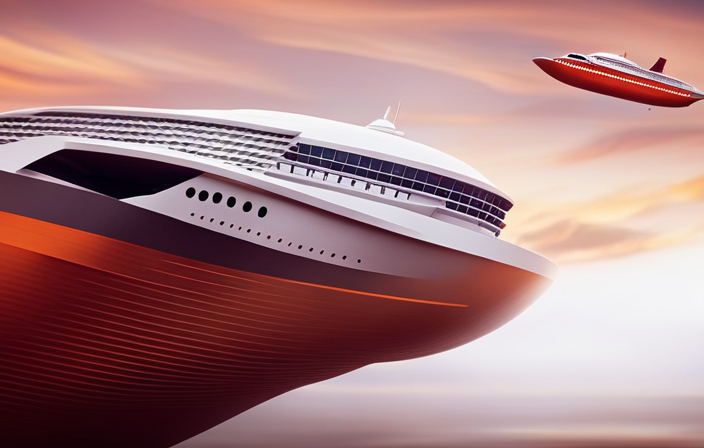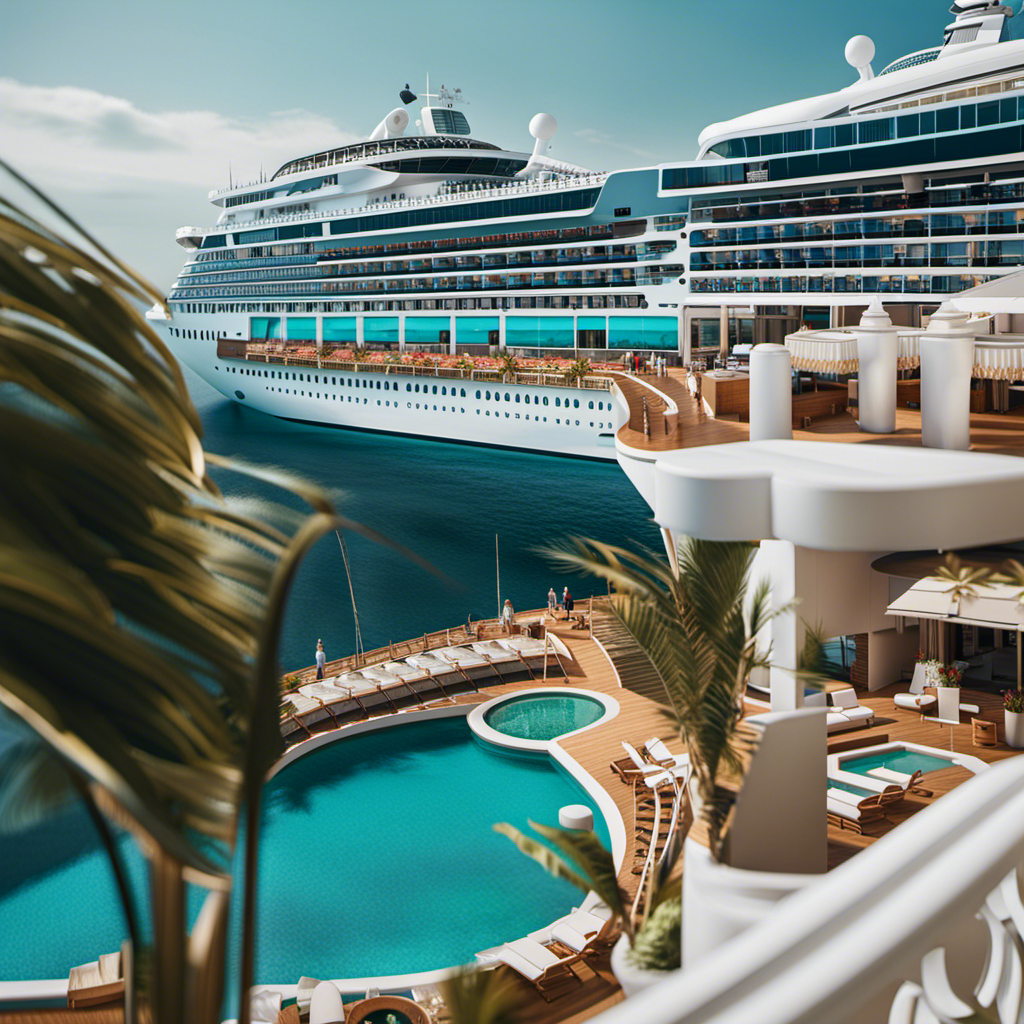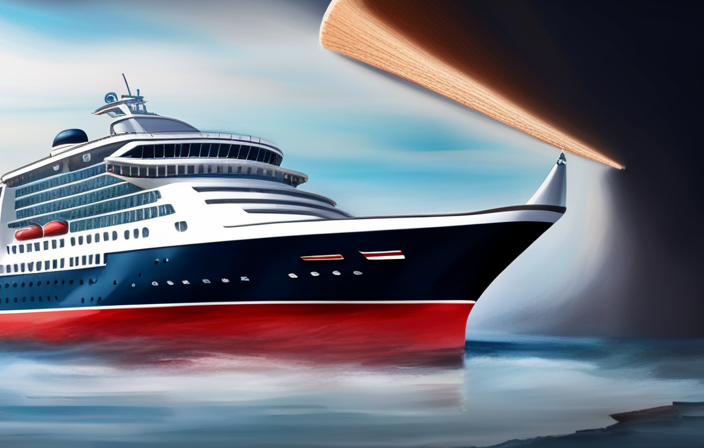In the realm of cruising, the term ‘dry dock’ is akin to a race car making a pit stop. It signifies a time when the vessel is taken out of water to undergo assorted maintenance and repair activities, all with the objective of ensuring its safety and reliability.
In this article, I will delve into the intricacies of what dry docking means for a cruise ship, from the process of taking the ship out of water to the inspections and renovations that take place during this time.
We’ll explore the importance of dry docking for maintenance and repairs, as well as the length of time and cost considerations involved. So, if you’ve ever wondered what goes on behind the scenes when a cruise ship is in dry dock, buckle up and join me on this technical and precise journey.
Key Takeaways
- Unforeseen issues during dry docking can cause delays and prolong the process, requiring careful planning and budgeting for maintenance.
- Proper budgeting and cost estimation are crucial, considering factors such as labor, materials, equipment rental, repairs, upgrades, inspections, and certifications.
- Dry docking is essential for ensuring safety and reliability through regular maintenance, inspections, repairs, and upgrades.
- Hull inspection, propeller cleaning and repair, replacement of worn-out parts, painting and corrosion prevention, and upgrades and modifications are key tasks during dry docking that enhance safety, performance, and the lifespan of the cruise ship fleet.
Definition of Dry Docking for Cruise Ships
Dry docking is like a spa day for cruise ships, where they are lifted out of the water and pampered with repairs and renovations. It is an essential process for the maintenance and upkeep of these massive vessels.
Regular dry docking is of utmost importance to ensure the smooth functioning and safety of cruise ships. During dry docking, the ship is taken to a dry dock facility where it is carefully positioned and secured. Once in place, the ship’s hull is inspected, cleaned, and repaired if necessary. The propellers, rudders, and other underwater components are also thoroughly checked and serviced.
Additionally, this process allows for the installation of new technology and the implementation of upgrades. Dry docking has a significant impact on cruise ship operations, as it ensures that the ship remains in top condition, maximizing its efficiency and minimizing the risk of breakdowns. It is vital for the seamless operation of the vessel and the satisfaction of its passengers.
Importance of Dry Docking for Maintenance and Repairs
Regular maintenance and repairs in a shipyard are crucial to ensure the smooth sailing and safety of a cruise vessel. The importance of regular dry docking cannot be overstated, as it allows for a thorough inspection of the ship’s hull, propellers, and other underwater components.
Dry docking provides an opportunity to identify and address any structural defects, corrosion, or damage that may have occurred during the ship’s time at sea. This meticulous examination ensures that the ship remains seaworthy and minimizes the risk of accidents or breakdowns during future voyages.
Additionally, dry docking allows for necessary repairs and upgrades to be carried out, such as replacing worn-out parts, repainting the ship’s exterior, or installing new equipment. These maintenance activities have a direct impact on cruise ship operations, as they contribute to the ship’s overall performance, efficiency, and passenger satisfaction.
Transitioning into the subsequent section about the process of taking the ship out of water, it is essential to understand the intricate steps involved in this crucial procedure.
Process of Taking the Ship Out of Water
The meticulous inspection and maintenance of a vessel in a shipyard necessitates the careful process of extracting it from the water. This process overview involves the use of dry dock facilities, which are specifically designed to lift the ship out of the water, allowing for easy access to its hull and propulsion systems.
During this extraction process, several emotions may arise in the audience:
- Awe: Witnessing the massive ship being lifted out of the water is a truly impressive sight.
- Anticipation: Excitement builds as the ship is prepared for its maintenance and repairs.
- Concern: There is a sense of concern for the ship’s condition and the work that needs to be done.
Once the ship is safely out of the water, the next step involves the inspection and assessment of the ship’s hull and propulsion systems. This crucial step ensures that any necessary repairs or maintenance can be identified and addressed effectively.
Inspection and Assessment of the Ship’s Hull and Propulsion Systems
Step aboard and let your eyes wander over the ship’s hull and propulsion systems, like a curious explorer discovering hidden treasures.
The inspection and assessment of the ship’s hull and propulsion systems during dry docking is a crucial process to ensure the vessel’s seaworthiness and safety.
Various inspection techniques are employed to thoroughly examine the hull for any signs of damage or corrosion. This includes visual inspections, ultrasonic testing, and thickness measurements.
Any identified issues are meticulously documented and assessed for necessary repairs or maintenance. Moreover, the propulsion systems, such as the propellers and shafts, are inspected for wear and tear, alignment, and overall performance.
Any necessary repairs or replacements are carried out to guarantee the ship’s optimal functionality.
These meticulous inspections and maintenance procedures help to keep the ship in prime condition for its subsequent renovations and improvements during dry docking.
Renovations and Improvements During Dry Docking
During dry docking, various renovation techniques are employed to improve and upgrade different aspects of the ship. These techniques adhere to strict dry dock regulations to ensure the highest standards of safety and quality are maintained. Renovation efforts focus on areas such as the ship’s interior design, cabin upgrades, public spaces, and dining facilities.
Advanced technology is integrated into the ship’s systems to enhance guest experience and safety. Additionally, improvements are made to the ship’s propulsion systems, including the installation of more efficient engines and advanced fuel-saving technologies.
By implementing these renovations, the ship is not only modernized but also optimized for optimal performance and guest satisfaction.
With these enhancements complete, the next step involves upgrading technology and safety systems, ensuring a seamless transition into the subsequent section.
Upgrading Technology and Safety Systems
Get ready to be blown away by the mind-blowing advancements in technology and safety systems that will revolutionize your cruise experience! During dry dock, cruise ships undergo extensive upgrades to their technology, enhancing safety measures to ensure a smooth and secure journey for passengers. Here are some of the exciting improvements you can expect:
-
Upgrading technology: State-of-the-art navigation systems and communication equipment are installed, allowing for more precise and efficient operations.
-
Enhancing safety: Advanced surveillance cameras and sensors are integrated to monitor the ship and detect any potential hazards or intrusions.
-
Improved emergency systems: Upgraded life-saving equipment, such as advanced fire detection and suppression systems, are installed to ensure the safety of passengers and crew.
-
Enhanced passenger experience: Cutting-edge entertainment systems, interactive displays, and high-speed internet connectivity are introduced to provide a more enjoyable and connected experience onboard.
As we delve into the next section on cleaning and painting the ship’s exterior, the ship will not only look fresh but will also be technologically advanced and safer than ever before.
Cleaning and Painting the Ship’s Exterior
After all the exciting upgrades, it’s time to give the ship a fresh new look by cleaning and painting its exterior.
Cleaning and maintenance of the ship’s exterior is an essential part of the dry docking process. This involves removing dirt, grime, and other debris from the ship’s hull and superstructure. High-pressure water jets are used to effectively clean the surfaces, ensuring a pristine appearance.
Once the ship is clean, it is thoroughly inspected for any signs of damage or corrosion. Any necessary repairs are made before the painting process begins. The ship’s exterior is carefully prepared by scraping off old paint and applying a primer to ensure proper adhesion.
Finally, a high-quality marine paint is applied to protect the ship from the harsh marine environment.
With the ship’s exterior looking brand new, let’s explore the length of time required for dry docking.
Length of Time Required for Dry Docking
You’ll be surprised to find out that dry docking can take quite a chunk out of your schedule, as it typically lasts anywhere from a few days to several weeks, depending on the extent of the maintenance and repairs required.
The length of time required for dry docking is influenced by several factors:
-
Ship size: Larger cruise ships often require more time in dry dock due to their increased complexity and size.
-
Scope of work: The more extensive the maintenance and repairs needed, the longer the dry docking process will take.
-
Availability of resources: The availability of skilled labor, equipment, and materials can also impact the duration of dry docking.
-
Unforeseen issues: Sometimes, unexpected problems may arise during the dry docking process, leading to delays and prolonging the time spent in dry dock.
Considering the length of time dry docking entails, it is essential for cruise ship operators to carefully plan and budget for this maintenance period.
Without explicitly stating the transition, it is evident that cost considerations and budgeting for dry docking are crucial aspects to be discussed next.
Cost Considerations and Budgeting for Dry Docking
Planning and budgeting for the cost of dry docking can be a challenging task for cruise operators. It requires a thorough cost analysis and careful financial planning. The expenses associated with dry docking can vary depending on the size of the ship, the extent of maintenance required, and the duration of the dry dock period.
Cruise operators need to consider costs such as labor, materials, equipment rental, and any necessary repairs or upgrades. Additionally, there may be additional expenses for inspections and certifications.
It is crucial for cruise operators to accurately estimate these costs and allocate the necessary funds to ensure a successful dry docking process. By doing so, they can maintain the safety and reliability of their ships, which will be discussed further in the next section.
Benefits of Dry Docking for Ensuring Safety and Reliability
Conducting regular dry dock maintenance ensures the safety and reliability of vessels in the cruise industry. Dry docking procedures involve taking a ship out of the water to carry out necessary inspections, repairs, and upgrades. This is done according to a carefully planned dry docking schedule, which takes into account factors such as the ship’s operational needs and regulatory requirements.
During dry dock, a ship is placed in a dock or a specialized dry dock facility. This allows for a thorough examination of the hull, propellers, and other critical components. The table below provides a visual representation of the various tasks performed during dry docking:
| Dry Docking Tasks | Purpose |
|---|---|
| Inspection of hull | Ensure structural integrity |
| Propeller cleaning and repair | Optimize propulsion efficiency |
| Replacement of worn-out parts | Enhance reliability |
| Painting and corrosion prevention | Protect against deterioration |
| Upgrades and modifications | Improve safety and performance |
By adhering to a well-planned dry docking schedule, cruise ships can address potential safety issues, ensure optimal vessel performance, and extend the lifespan of their fleet.
Frequently Asked Questions
How often do cruise ships typically undergo dry docking?
Cruise ships typically undergo dry docking every 2-3 years. The dry docking duration can range from a few days to several weeks, depending on the extent of maintenance, repairs, and renovations needed.
What are some common maintenance and repair tasks performed during dry docking?
During dry docking, maintenance tasks such as hull cleaning, propeller inspection, and painting are performed. Repair tasks may include replacing worn-out parts, fixing mechanical systems, and upgrading the ship’s amenities.
Are there specific regulations or standards that govern the dry docking process for cruise ships?
There are specific regulations and standards that govern the dry docking process for cruise ships. These guidelines ensure safety, environmental compliance, and proper maintenance procedures are followed during the maintenance and repair tasks.
How does dry docking contribute to the overall safety and reliability of a cruise ship?
Dry docking benefits the safety and reliability of a cruise ship by allowing for thorough inspections, repairs, and maintenance. The meticulous dry docking procedures ensure that the ship is in top condition, minimizing risks and enhancing its performance.
Can passengers be onboard during the dry docking process, or are they required to disembark?
Passengers are required to disembark during the dry docking process due to passenger safety regulations. This ensures that all necessary maintenance and repairs can be carried out without any risk to the passengers.
Conclusion
In conclusion, ladies and gentlemen, let me enlighten you on the marvels of dry docking for cruise ships.
This miraculous process ensures the safety and reliability of these floating behemoths.
With meticulous inspections, assessments, and renovations, we transform these vessels into masterpieces of engineering.
Cleaning and painting the exterior is like giving them a spa treatment, making heads turn in awe.
And while dry docking may be time-consuming and expensive, the benefits it brings to the table are worth every penny.
So, let’s raise a toast to the dry dock, the unsung hero of the cruise ship world!
Alfons is the visionary leader and driving force behind Voyager Info’s success. As the Editor in Chief, he brings a wealth of experience and an unwavering passion for travel to the helm of our cruise-centric platform.
With a lifelong fascination for exploring new horizons, Alfons discovered his love for the ocean and cruising at a young age. From sailing across pristine Caribbean waters to embarking on daring expeditions to far-flung destinations, he has amassed a treasure trove of first-hand experiences in the world of cruising.











